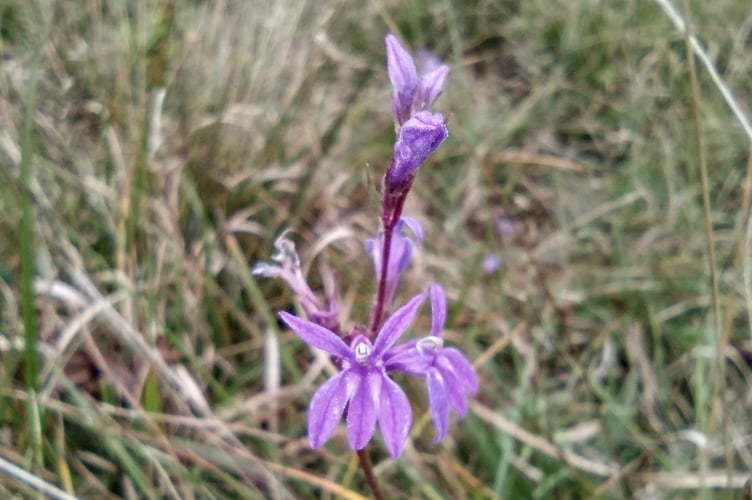I am proud to say that I have worked for Devon Wildlife Trust.
Just think about it for a moment. It is an organisation with an unenviable task of protecting and managing a diverse range of both terrestrial and marine habitats and species across this huge county. As charities, the Wildlife Trusts depend on funding through membership and many other, often fluctuating, income streams, fighting for their share of the pie in a highly competitive arena. They are responsible for numerous nature reserves, many with designated status; for employees and volunteers; for campaigning, advising and awareness-raising; for novel and long-term research; and must be accountable for all that they do. Volunteers have been the life-blood of wildlife trusts throughout their many decades and through myriad changes; changes in both how the organisations operate and in our evolving relationships with wildlife and the wider environment.

Now I am proud to say that I am a volunteer for Devon Wildlife Trust!
Following a serendipitous rejigging of my work days, I found myself released to join the Andrew’s Wood ‘Thursday group’, led by DWT volunteer coordinator, Lineke. I was introduced to Lineke in the summer when, for the first time, the long-term monitoring of Heath Lobelia, for which the site is designated, did not coincide with the Loddiswell Show. Thrilled at the prospect of a day spent counting the delicate blue flower spikes amidst bird song and jovial company, I eagerly anticipated the event. Alas, the weather was not our friend that day, yet the enthusiasm of the group was unquenchable and we ploughed on in wellies, waterproofs and high spirits.
It was not just the rain we had to contend with: Covid and other factors over recent years had resulted in a bit of a hiatus in scrub control so that in the damp meadows birch, willow, bramble and other scrub had encroached, growing tall and dense. Walking in straight lines along the survey transects was nigh on impossible but we did our best, recording each Lobelia plant along the way. Even with a waterproof clipboard, the paper quickly became damp and began to disintegrate and so, after managing just two fields, we agreed to call it a day. Looking at the bedraggled yet still beaming team, especially Mr Gordon Waterhouse, I thought a group photograph was in order, capturing the indomitable spirit of the wildlife volunteers!

It was clear from our observations that day, together with evidence from the years of painstaking recording, that the populations of Heath Lobelia were not thriving in the overgrown meadows. Lineke agreed to discuss this further with the DWT Reserves’ Team and come back with a conservation plan going forward, to work with the volunteers tackling the dense scrub, and with the graziers, Cows in Clover, to open up the grassland and create areas of exposed mud where Lobelia seed can germinate and thrive without being smothered.

So, last Thursday, I joined the team at the Cuckoo Field entrance from where we slipped, slid and sploshed our way to the clearing at the centre of the site, armed with loppers and bowsaws. It was muddy! There, Lineke instructed us to prioritise willow and birch for cutting and to distribute the brash as dead-hedging along the boundaries. She also encouraged us to be mindful of dormouse hibernation nests when we were working or dragging cut material across the site, adding that one had already been discovered. Intrigued, I asked if she could point it out to me as I had never actually seen one in the natural environment, only those made inside dormouse boxes. Leading me across to where another team member had been working, she hunted through the vegetation.
“Ah, here it is”, she said, and squatting down low. I looked to where she was pointing. A grapefruit sized ball of woven grass and other plant material hung suspended in a tangle of bramble and bracken stems. How amazing to think that deep inside, a tiny dormouse was sleeping.
Gordon and I teamed up to work on an area where Twayblade orchids had once thrived. Hopefully opening up this grassland to more light would encourage their long-dormant seed to germinate. Like Heath Lobelia, it fares better where competition with other plants is much reduced.
In contrast to my previous volunteer day, the sun broke through, forcing us to shed jackets and linger longer at our late morning tea break, enjoying the contents of Lineke’s biscuit box – especially the gingerbread cinnamon-creams.
Finally, by mid-afternoon, I was surrounded by heaps of brash. As I headed towards the field boundary with an armful, I passed a tall grass tussock, its centre filled with a tangle of dead grass. I stopped, retraced my steps and took a closer look: not tangled but woven – yes, it was another dormouse nest!




